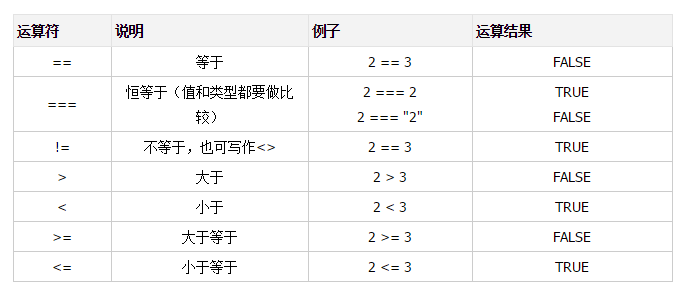Operator
First we need to know what an expression is
For example i++; a+b These are all expressions
Unary operator: can only operate one value operator, called the unary operator
increment ++ and decrement- -
Look at the following code:
<!DOCTYPE html> <html> <head> <meta charset="utf-8"> <title>运算符</title> </head> <script type="text/javascript"> var box=100; box++; //box--; //++box; //--box; document.write(box); </script> <body> </body> </html>
The front is incremented, output 101 The rear is incremented and output 101
The front is decremented, the output is 99 The rear decrement is output 99
Note: The difference between preposition and postposition
var box=100;
//age = ++box; //First add the box to 101, and then assign it to age
//= box ++; //First assign box to age, age=100, and then accumulate
//age = --box //First reduce box to 99, Then assign the value to age
//= box -- //First assign the box value to age age=100, and then subtract
+ -Operator
var box=100;
+box; //Positive number
-box //Negative number
The plus sign (+) has an automatic transformation function
As shown in the following code
<!DOCTYPE html> <html> <head> <meta charset="utf-8"> <title>一元运算符</title> </head> <script type="text/javascript"> var box="89"; alert(typeof +box); //如果没有加号,是string类型,有加号则是number类型 </script> <body> </body> </html>
Arithmetic operator
Add(+)
<!DOCTYPE html> <html> <head> <meta charset="utf-8"> <title>算术运算符</title> </head> <script type="text/javascript"> var a = 10; var b = 15; var c = a+b; document.write(c); </script> <body> </body> </html>
Minus(-)
<!DOCTYPE html> <html> <head> <meta charset="utf-8"> <title>算术运算符</title> </head> <script type="text/javascript"> var a = 10; var b = 15; var c = a-b; document.write(c); </script> <body> </body> </html>
Multiply(*)
<!DOCTYPE html> <html> <head> <meta charset="utf-8"> <title>算术运算符</title> </head> <script type="text/javascript"> var a = 10; var b = 15; var c = a*b; document.write(c); </script> <body> </body> </html>
Division(/)
<!DOCTYPE html> <html> <head> <meta charset="utf-8"> <title>算术运算符</title> </head> <script type="text/javascript"> var a = 15; var b = 15; var c = a/b; document.write(c); </script> <body> </body> </html>
remainder (%)
<!DOCTYPE html> <html> <head> <meta charset="utf-8"> <title>算术运算符</title> </head> <script type="text/javascript"> var a = 15; var b = 5; var c = a%b; document.write(c); </script> <body> </body> </html>
Assignment operator

Assignment operator Nested use of operators: the following case
<!DOCTYPE html> <html> <head> <meta charset="utf-8"> <title>赋值运算符</title> </head> <script type="text/javascript"> y = ( x = 2) + 5; alert(x); alert(y); </script> <body> </body> </html>
Comparison operator

Ternary operator
Syntax: Expression 1 ? Expression 2: Expression 3
Example:
<!DOCTYPE html> <html> <head> <meta charset="utf-8"> <title>三元运算符</title> </head> <script type="text/javascript"> var x = 5; y = (x=5)?x:1; document.write(y); </script> <body> </body> </html>
Note: If expression 1 is true, the output result is expression 2, otherwise it is expression 3; For example, in the above case x=5;, judge whether expression 1 is true. If true, output the value of
## &&(The conditions must be met at the same time to be true) x=2;y=6; x&&y>6 ; At this time, x and y only have One item satisfies greater than 6, so the result is false; ||(As long as one of the conditions is met, it is true) x=2;y=6; x||y>6 ; At this time, one of x and y satisfies the condition, so the result is true; !(take The logic is worth the opposite, if it is true, take false, if false, take true) x=5;y=8; !(x>y); First, judge whether x is greater than y. If it is not greater, it is false. If it is not false, it is true, so the result is true ##String linker + <!DOCTYPE html>
<html>
<head>
<meta charset="utf-8">
<title>字符串连接符</title>
<script type="text/javascript">
var a = "中国,";
var b = "你好";
var c = a + b;
document.write(c);
</script>
</head>
<body>
</body>
</html>